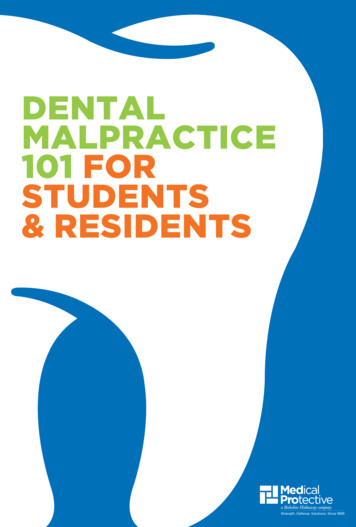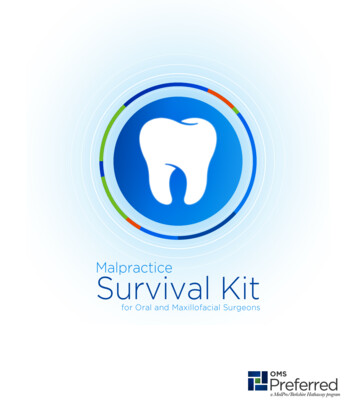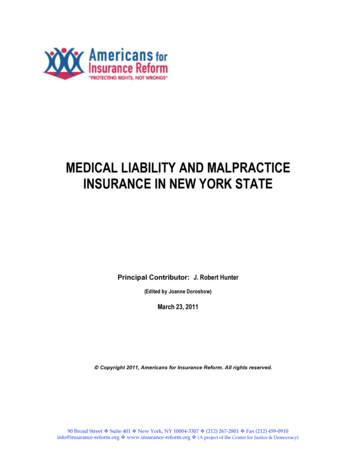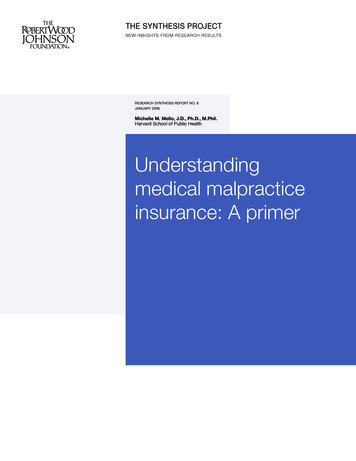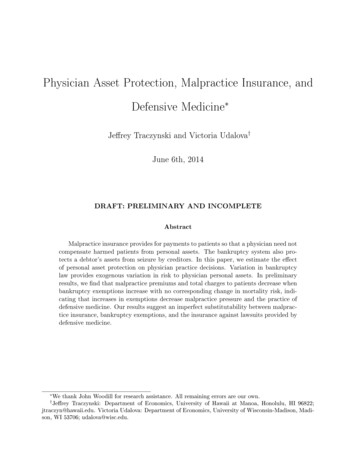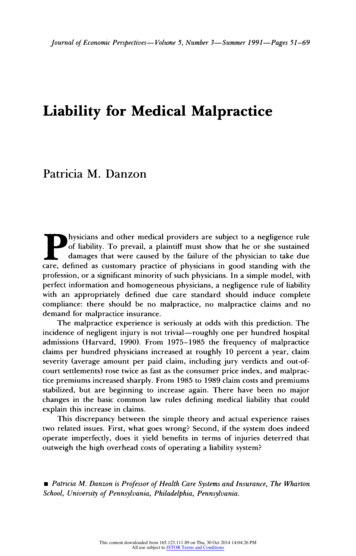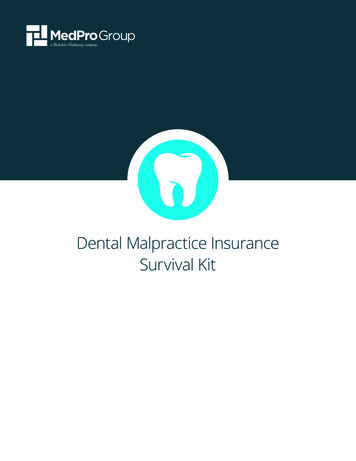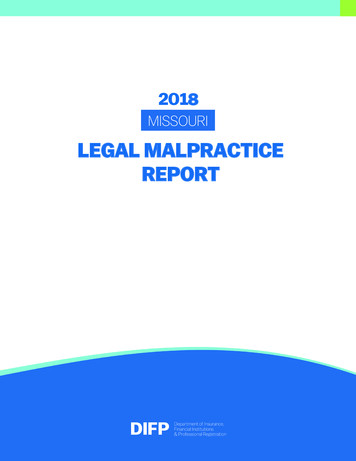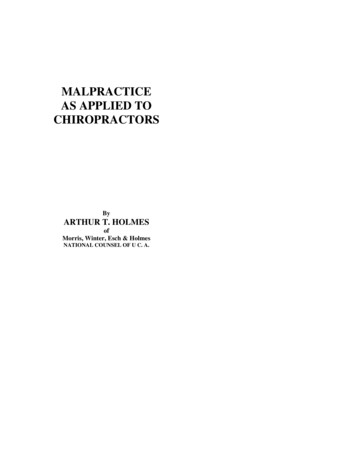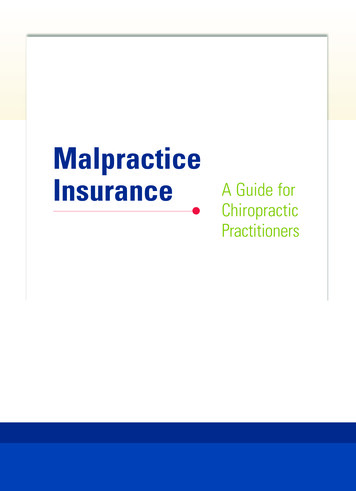
Transcription
MalpracticeInsuranceA Guide forChiropracticPractitioners
Choosing the BestChiropractic Coverage for YouEven the best doctors can be accused of makinga mistake, can have a bad outcome, or be hit withan unwarranted allegation of malpractice. That’swhy choosing the right malpractice coverage isso important. Your policy protects your patients,your financial well-being and your reputation. Inthe unfortunate event of an injury, you’ll want toensure that your malpractice insurance is sufficientto compensate your patient and protect you andyour practice.In addition, being subject to a claim is stressfulenough without having to wonder if your coverageis adequate or if you’ll be defended effectively.That’s why the time to understand your malpracticeinsurance coverage is before you need it.So, when choosing a malpractice insurancepolicy, you should know the answers to thefollowing questions: Choosing a Malpractice Insurance Policy1.2.3.4.5.What does the policy cover?How much coverage do I need?What types of policies are available?How does the policy’s consent-to-settle feature work?What is the company’s expertise and involvementwith the profession?6. Is the company financially stable?7. What does the policy cost?A Guide for Chiropractic Practitioners – 3
Policy Should Cover Defense CostsAt NCMIC, our policy pays unlimited defense costs inaddition to jury awards or settlements. For example, if youhave a 1 million policy limit on your malpractice coverage,you would be covered for up to 1 million per claim in juryawards or settlements, PLUS unlimited defense costs.What does thepolicy cover?In the event of a lawsuit, you face apossible loss of business, time away frompatients, a potentially damaged reputationin the community, not to mention thepersonal anguish experienced by you,your family and your office staff. To ensureyou’re properly protected, it’s critical thatyou understand a policy’s indemnity, legaldefense and supplemental coverages.(See limits of liability in the next section.)Legal DefenseYour malpractice insurance companyis responsible for providing you witha defense and paying for it. This is asignificant part of your coverage becausedefending a chiropractic malpractice claimcan easily cost tens, even hundreds, ofthousands of dollars. Even if you’ve donenothing wrong, the cost to defend a claimcan be significant. Clearly one of thebiggest expenses for a malpracticeinsurer is providing a defense to the doctor.IndemnityOne of the main purposes of malpracticecoverage is to pay damages sufferedby the plaintiff (patient). The amount ofmoney paid to the plaintiff as the resultof a settlement or award is called anindemnity payment.Payments for indemnity are availableup to the limits of liability of your policy.How much coveragedo I need?Determining your level of coverage isan important part of your decision toprotect your patients, practice and assets.You’ll want to take into consideration theBecause NCMIC’s Malpractice Insurance Plan was created by chiropractors forchiropractors, each benefit was designed with your needs as a D.C. in mind. Our motto “We Take Care of Our Own ” reflects our commitment to give youthe kind of protection you deserve.4 – Malpractice Insurance
One practice some insurance companies employ is to have doctors enter into arbitrationagreements with their patients. This requires you to ask your patients to sign a formmandating that they submit to arbitration should they decide to pursue an allegation ofmalpractice.Arbitration is less expensive for the insurance company because the doctor gives upthe option to go to court. The doctor may more likely be found at least partially at faultbecause the arbitration process typically favors compromise. Further, some states do notuphold arbitration agreements for insurance policies because they bar the constitutionalright to a jury trial.Under this provision, any claim by the patient is presented to an arbitrator for review,and both you and the patient forfeit the right to pursue litigation. Arbitration is binding,so there is no appeals process.NCMIC does not believe arbitration agreements are in the best interest of our policyholdersor their patients. Our coverage never requires doctors to enter into these agreements withtheir patients.amount of money that may be needed bya patient who was inadvertently injured asa result of treatment, as well as sufficientcoverage to protect your other patients,your practice and your financial future.There are other factors, as well. Thirdparty payer contracts generally requireyou to carry malpractice insurance withcertain limits of liability, so be sure to ask Options for Policy LimitsNCMIC offers a variety of policy limitoptions, so you can choose the rightlevels to meet your obligations as wellas your specific needs and preferences.the provider relations department of anynetwork in which you participate abouttheir requirements. In addition, statestatutes may require coverage minimums,and an employer may require similarpolicy limits for everyone in the office.It’s important to keep in mind that lowerpolicy limits can affect the outcome of acase. Lawsuits are often a process ofnegotiation and compromise, and if yourpolicy limits are inadequate to negotiatea settlement, they can become a barrierto reaching a successful outcome.Moreover, low policy limits can alsoexpose your personal assets if ajudgment exceeds policy limits. Then,you are liable to pay the excess.A Guide for Chiropractic Practitioners – 5
Figure 1 1 Milllion/ 3 MillionLimits of Liability 3M 2MMaximum amountpaid for each annualpolicy period ( 3M) 1M 0Maximum paidfor any oneclaim ( 1M)As you can see, the issue can becomplex, so it is wise to consult withyour accountant, lawyer, or anotherbusiness advisor to assist in determininghow much coverage you need. Then,revisit your malpractice coverage annuallyto make sure you have adequate protectionas your practice grows or changes.Malpractice insurance policies offer awide range of limits for both single claimsand total claims per year, known as singleclaim limits and aggregate limits. In Figure1, the inset section refers to the maximumamount your policy will pay for any oneclaim. The entire graph represents themaximum amount your policy will payduring each annual policy period.6 – Malpractice InsuranceWhat types of policiesare available?There are two basic types of malpracticeinsurance: occurrence and claims-made.Ideally, your malpractice insurancecompany should offer both occurrenceand claims-made policies, so you candecide which is best for your individualcircumstances.It is important to understand that bothtypes of policies have the same coverageand both will provide you with a defense.What differs between the two is how andwhen the coverage triggers.An occurrence policy providescoverage against claims for allegedincidents that occur anytime during thepolicy period. Even if the policy hasexpired or been canceled, if the allegedincident occurred while the policy wasin force, the coverage is there.In other words, if an act or omissionallegedly causing an injury occurs today,then the occurrence policy that’s ineffect today would cover you against amalpractice claim, regardless of whenthat claim is made.Why is this important? Most claimsare filed relatively soon after thetreatment or incident in question, butsome lawsuits have been filed andsuccessfully litigated for incidents thattook place many years earlier. This is
particularly relevant when minors areinvolved or when the alleged injurydoesn’t manifest itself until much later.gaps can occur, and you need to workclosely with your insurance company atthe time of cancellation to ensure allpotential gaps are identified.Claims-made coverage, on the otherhand, provides coverage against claimsfor alleged incidents that both occur andare reported during the policy period. Thefirst day claims-made coverage begins iscalled the retroactive date, or “retro” date.Claims-made coverage is triggered when:1) The alleged injury occurs onor after the policy’s retro date.2) A written claim is made and reportedduring the current policy period orwithin the term of the policy or anyextended reporting period following thecurrent policy period, generally 60 daysfollowing termination of the policy.Occurrence vs.Claims-made PremiumsAlong with understanding the differencein the coverage triggers of occurrenceand claims-made policies, it is importantto understand the difference in thepremiums.Occurrence policies offer a steady basepremium. The base premium does notincrease as the policy matures.The claims-made policy offers a lowerpremium during early years of the policy.The premium steps up each year untilreaching maturity in year five of the policy.While this saves some money in yourearly years of practice, potential coverageFigure 2 on the following page mapspotential gaps in coverage whenmoving from one claims-made policyto another.Avoiding Gaps in Coverage withClaims-made CoverageIt is important to make sure that agap in your malpractice coveragedoesn’t occur.A gap in coverage can result in anumber of ways. If the retroactive date(coverage date) of a claims-made policychanges, a gap in coverage may result.The timeline (Figure 2) shows whathappened when a doctor switched froma claims-made policy with CompanyA (Policy Period 1) to a claims-madepolicy with Company B (Policy Period 2)and did not purchase tail coverage fromCompany A or prior acts coverage fromCompany B. This switch resulted in achange to the doctor’s retro date. Thissame scenario would apply if thecoverage was completely canceled.As shown above, the injury occurredduring Policy Period 1. Because thedoctor changed coverage and did notpurchase tail coverage from Company Aor prior acts coverage from Company B,he has a new retro date. Consequently,A Guide for Chiropractic Practitioners – 7
Figure 2Policy Period 1Company APolicy Period 1Company BPolicy Period 2Because the D.C. did not purchase tail coverage or prior acts coverage,injuries occuring before 1/1 are not covered by Company B.an injury that occurred 7/1/10 but was notsubmitted by the patient until 7/1/11 wouldnot be covered by either Company A orCompany B.by you or the insurance company thatissues it. Generally, tail coverage may notbe purchased if the policy was canceledfor non-payment of premium.This gap represents a significant risk tothe doctor and his/her patients. To avoida gap in coverage when canceling yourpolicy or switching insurance companies,you need to purchase either tail coveragefrom your former insurer or prior actscoverage from your prospective insurer.Without this additional coverage, there isno coverage for the entire period of timethe previous policy was in place.How does the policy’sconsent-to-settlefeature work?One of the most critical features of amalpractice insurance policy is whetherit gives you the authority to settle—ornot settle—a malpractice claim.When purchasing tail coverage, you needto understand the terms of its coverage.Typically, tail coverage must be purchasedwithin a certain period of time followingcancellation. It is a one-time purchase,does not expire and cannot be canceledAll policies name the party who isauthorized to give consent to settle,but not all are created equal. The idealconsent to settle is one that can beauthorized only by the insured (you),period.NCMIC provides tail coverage at no additional charge after 10 years of continuouscoverage. When switching from another company to NCMIC or when switching fromone type of NCMIC coverage to another, we will work with you to make sure that allcoverage issues are addressed, gaps are identified and solutions are suggested foryour protection. Don’t cancel any coverage without checking with us first.8 – Malpractice Insurance
NCMIC offers a true consent-to-settle clause.* So, in the event of a malpracticeallegation, NCMIC will support you every step of the way and will not settle aclaim without your authorization. So, if you decide you want to pursue the case,you’ll have your day in court. What’s more, the NCMIC policy does not includearbitration or hammer clauses.* Not allowed by Maryland.However, some policies have clauses thatlimit a doctor’s decision to settle or not.Two variations are:Hammer or Modified HammerClauses. If the policy contains aHammer Clause and during the claimthe doctor refuses to consent to anysettlement recommended by the insurancecompany, the doctor becomes personallyresponsible for any judgment in excessof the proposed settlement amount.The insurance company may wish to settlefor a number of reasons. For example, ifthere are poor medical records in thecase, unresolved conflicts between yourtestimony and others’, or personal/professional problems that could influencea jury if disclosed at trial, settlement maybe rigorously pursued by the insurancecompany. If the company believes you areunreasonably withholding your consentto settle, the company will invoke thehammer clause.A settlement can save the insurancecompany money by shortening thelitigation process, but it forces doctorsto make some difficult decisions aboutwhether to continue to fight and provetheir innocence. Doctors must alsoconsider the impact on their personalfinances if they press on with the claim.Arbitration Clauses. Another clausefound in professional liability policies thataffects the doctor’s consent to settle is thearbitration clause. If an insurance companydeems an offer to settle a claim or suitis proper and the doctor is withholdingconsent, the insurance company canhire an arbitrator to decide if the consentis being unreasonably withheld. Then, ifthe arbitrator decides the doctor is beingunreasonable in withholding his or herconsent, the insurance company canproceed to settle the case without thedoctor’s consent.Because of its impact on your reputationand profession, it’s important that youhave a policy with a true consent-to-settleclause that gives you—not the insurancecompany—control regarding whetherto settle.What is the company’sexpertise andinvolvement with theprofession?When it comes to protecting yourreputation, you don’t want to take chances.A Guide for Chiropractic Practitioners – 9
It’s vital to have a knowledgeable,experienced company that specializesin chiropractic fighting for you.An experienced malpractice insurancecompany will know the latest chiropracticissues, chiropractic-specific cases,litigation strategies, and so on. In contrast,a doctor’s defense may suffer if Claims are outsourced to an outsideinsurance company. Neither the claims staff nor theD.C.’s defense attorney know muchabout chiropractic issues. There’s a lack of respect for thechiropractic profession by the claimsstaff or the attorney.What’s more, it’s important to ensureyour malpractice company is investedin giving back to chiropractic ratherthan just benefiting from it. Look forcompanies that support chiropracticresearch and education programs, takean active role in state and nationalprofessional organizations, andunderstand the chiropractic issuesfacing the profession today. Anotherimportant consideration is how thecompany supports the chiropracticcolleges. Ask if the company has . Provided funding for research thatenables curriculum enhancements. Offered a business educationtraining program for students throughthe colleges. Expanded risk managementeducation and materials to teachcolleges, students and practitionersabout malpractice business risks.10 – Malpractice Insurance NCMIC Supports ChiropracticBack in 1946, NCMIC was formedby a group of chiropractors with theexpress purpose of offering malpracticeinsurance to D.C.s at a time when noone else would. Today, we’re just asdedicated to chiropractic. NCMIC hasgiven more than 12.9 million tochiropractic research and educationsince 1995. NCMIC also offersbusiness training and malpracticerisk management seminars andresources to D.C.s as a complementto the education provided by thechiropractic colleges.We also support chiropracticassociations and colleges by providingspeakers free of charge and offeringpremium discounts to our policyholderswho attend qualifying programs. Inshort, NCMIC is committed to thechiropractic profession, continuallyfostering growth and advancementthrough investment and collaboration.Is the companyfinancially stable?It is critical that the insurance companyyou choose will be there for you over thelong term.One good way to check this is to assessa company’s financial position, includingtheir A.M. Best ratings. A.M. Best isan independent industry analyst thatevaluates insurance companies’ financialstrength and operating performance.Their ratings range from A to S.*
You should look into a company’s assets,ask to see a copy of its annual report orfinancial summary, check on complaintsor problems through your state insurancedepartment and find out how long thecompany has been in business. Morespecifically, find out how long the companyhas been in the chiropractic market.It is important to find out who ownsthe company. Is the company publiclytraded so that shareholders, notpolicyholders, are the company’s focus?Is it a mutual company owned by itspolicyholders? And who are thosepolicyholders . chiropractors like youor medical doctors? Is it owned by abroker who places your policy with acompany of his or her choosing, or areyou working directly with the companythat is providing coverage?What does thepolicy cost?When looking at price, there are severalthings to consider. It is important to lookat the value you will receive for yourpolicy dollar.When it comes to protecting yourreputation, you don’t want to cut corners.It’s vital to have a knowledgeable,experienced company fighting for you.Moreover, it’s important that you receiveexcellent service whether you’re callingabout a payment, policy details, a claim,or for advice about a troubling situation.Protecting your good name. Thevalue of your malpractice coveragebecomes apparent if you become subjectto a malpractice claim. Because theNCMIC has a firm commitment to chiropractic, writing malpractice insurance forchiropractors practicing all 50 states, plus Puerto Rico, the Virgin Islands and Guam.NCMIC has continued to retain an A.M. Best rating of “A” (Excellent). This is asignificant accomplishment considering that many insurance and financial institutionshave had difficulty maintaining their ratings.Additionally, policyholders of NCMIC are members of National Chiropractic MutualHolding Company, owned by its chiropractic policyholders. As further evidence ofour financial stability and commitment to our policyholders, we have offereda premium dividend every year since 1996 (though this is not guaranteed).With Doctors of Chiropractic actively involved throughout many areas of the company,we understand chiropractic, the challenges you face each day and the issues involvedwith malpractice allegations. In short, we ARE the chiropractic malpractice experts.* A.M. Best ratings range from A to S. For more information, visit www.ambest.comA Guide for Chiropractic Practitioners – 11
NCMIC’s Malpractice Insurance Plan Discounts1stYear License75% D.C.s licensed forthe first timewithin 18 monthsof graduationwho signup for NCMICcoverage within1 year of theiroriginal licensuredate.2ndYear License40%3rdYear License25%4thYear License15%RiskManagement5%D.C.s licensedwithin 30 monthsof graduationwho sign up forNCMIC coveragewithin 2 years oftheir originallicensure date.D.C.s licensedwithin 42 monthsof graduationwho sign upfor NCMICcoveragewithin 3 yearsof their originallicensure date.D.C.s licensedwithin 54 monthsof graduationwho sign up forNCMIC coveragewithin 4 yearsof their originallicensure date.D.C.s whocompleteNCMICapproved riskmanagementseminars.The discountwill apply for3 years. Claims-free3% to 20% D.C.s coveredby NCMIC forat least 3consecutiveyears who havenot had a claimfiled againstthem. (Alsoavailable toD.C.s whohave beenclaims free withanother carrier.)Policyholder discounts may be different in N.Y. and N.J.; please call for details. Part-time discount available, call for details.chiropractic profession is unique, it’simportant that your legal counsel andclaims representatives understandchiropractic and are experienced inputting together a chiropractic defense.When your reputation is on the line,you want the best representation andcoverage possible.There is no substitute forexperience. It’s important to look forexperience defending chiropractors andin-depth expertise on the subject ofchiropractic malpractice. The support of aprofessional claims staff means you maybe able to receive guidance even beforeyou face a claim.In addition, your coverage will providea better value if it includes broad scopeof practice coverage, a true consent-tosettle provision, and supplemental12 – Malpractice Insurancecoverages such as professionaldiscipline and other governmentalproceedings at no additional charge.On-going customer servicesupport is vital. One of the thingsyou’re paying for in a malpractice policyis service. It can make your life easierto call one place whether you’re callingabout your policy, a claim or simplyhave general questions.Some companies outsource their servicesto large medical organizations, meaningyou don’t get the expert, personalizedservice you deserve. Instead, look for acompany that puts an emphasis on treating policyholders with the utmost respect.Another helpful feature is the ability to goonline to manage your policy. It is nice to
With NCMIC’s plan, a variety of premium discounts may be available to you as anNCMIC policyholder. And, while not guaranteed, NCMIC’s policyholders have receiveda premium dividend every year since 1996.What’s more, you won’t be required to pay any membership fees. Other plans mayrequire you to pay up to 200 in membership fees in addition to your premiums.be able to make payments, access formsand get the information you need whenit’s convenient for you.yet a policyholder? You can viewthe current issue by going n.Valuable extrasAt NCMIC, we also offer you value-addedextras including: Legal expertise—NCMIC maintainsa nationwide network of highlyrespected defense attorneys withyears of experience in defendingchiropractic malpractice cases. Wehost conferences for our attorneyswhere they hear from worldwideexperts, learn about chiropracticresearch and exchange strategieson defending D.C.s. Claims Advice Hotline—Policyholders can call to confidentiallydiscuss any concern or situationthey’re not sure how to handle. Continuing education seminarsand monographs—Keep doctorsup to date on developments inchiropractic. Examiner—Quarterly publicationwith compelling cases studies and tipsavoiding malpractice allegations. NotThe NCMICMalpractice InsurancePlan . For the wayyou practice nowBecause NCMIC's Malpractice Planwas created by chiropractors forchiropractors, each benefit was designedwith your needs as a D.C. in mind. Ourmotto, “We Take Care of Our Own ,”reflects our commitment to give youthe first-rate, personalized service andprotection you deserve. A variety ofadditional coverages are available, ifallowed by your state, allowing you tocustomize your protection for the wayyou practice now and in the future.Coverages include: 25,000 Supplemental Legal DefenseEndorsement available at noadditional charge.1 ThisA Guide for Chiropractic Practitioners – 13
endorsement includes defensecoverage for State DisciplinaryProceedings, civil sexualmisconduct allegations, WrongfulBilling and Related Proceedingsfor federal/state funded programs,HIPAA and Privacy RelatedProceedings, and QualityImprovement Organization(QIO) Review. Chiropractic Entity Coverage withShared Limits of Liability at no2additional charge. Protects thecorporation, association orpartnership from liability due tothe negligent acts of employees.Separate limits of liability availablefor an extra charge. Peer Review and Utilization Review.Coverage for rendering an opinionon the adequacy, necessity orreasonableness of care furnishedby another practitioner, based ona review of the patient’s recordswithout a physical examination.Coverage is also provided forreview or evaluation of professionalservices rendered by a professionalpractitioner for the purposes ofdetermining competency. Providesfor payment of the reasonable legalfees and expenses of a lawyer anddamages within limits of liability of 25,000 per incident and 50,000per policy period. Does not have torelate to a malpractice action. An additional 5,000 in ProfessionalDiscipline Coverage for each incident(up to 10,000 each policy period)to pay your defense costs forappearances before a stateicensing board in addition to theSupplemental Legal Defensecoverage. Dual License Coverage for D.C.swho hold an additional licenseas a naturopathic physician,acupuncturist, massage therapist3or physical therapist. Doctors ofChiropractic who hold an additionallicense as a naturopathic physicianor acupuncturist can now becovered under the same policyfor both licenses for a nominaladditional premium. No additionalpremium is charged for chiropractorswho maintain a second license asa physical therapist or massagetherapist.1 Coverage for civil sexual misconduct allegations is different in NY.The state of NY only allows vicarious liability coverage for civilsexual misconduct allegations committed by others for whomyou are responsible.2 Shared limits are not allowed by CT or KS.3 Dual license coverage for Physical Therapy is not available in MA.visit us atncmic.com14 – Malpractice Insurance
Comprehensive List of NCMIC’s Benefits and Features NCMIC’s PlanCompany 65 years of experience in chiropractic malpractice Supports and insures chiropractic colleges andUniversities across the U.S. Founded by Doctors of ChiropracticPlan features and benefits True Consent-to-Settle feature* No arbitration clauses All legal fees paid outside policy limits 25,000 Supplemental Legal Defense Endorsement atno additional charge** An additional 5,000 for state disciplinary proceedingsPremium discounts For new practitioners For claims-free record For part-time status For risk managementClaims Claims-made and occurrence plans available Expert defense attorneys and claims staffwho specialize in healthcare malpractice Hotline for questions regarding a potentialclaim or a delicate situationExtras No membership fees Premium dividends paid every year since 1996*** FREE subscription to risk management magazine Underwriting, claims and service handled in oneplace—no outside broker or outside call center Online educational resources available for riskmanagement and business training* Consent to Settle is not allowed by MD.** Subject to underwriting approval. *** This is not a guaranteed benefit.A Guide for Chiropractic Practitioners – 15
In addition to NCMIC’s Malpractice Insurance Plan, the NCMIC familyof companies is proud to offer or make available the following productsand services. Each one is geared to your unique needs as a D.C.Other NCMIC Products and Services Financial Products Credit Card Processing MilesAway MasterCard Insurance Services and Plans Auto and Homeowners Protection Business Owners’ Insurance General Liability D.C. Long Term Disability Insurance* Workers’ Compensation Insurance Employment Practices Liability Insurance (EPLI)For more information regarding these offeringsor NCMIC’s Malpractice Insurance Plan,call 1-800-769-2000, ext. 3344.The NCMIC Malpractice Insurance Plan is offered through NCMIC Insurance Company. In the states of Florida and New York, the NCMICMalpractice Plan is issued by NCMIC Risk Retention Group, Inc. Auto and Homeowners, Business Owners’ and General Liability Insurance areunderwritten through partnerships with some of the industry’s leading insurance carriers. NCMIC Insurance Services is a licensed insuranceagency (CA license #0B84564). Credit Card processing and MilesAway credit card are offered through NCMIC Finance Corporation.MilesAway is a registered service mark of NCMIC Finance Corporation. MasterCard is a registered trademark of MasterCard International.* Coverage under the D.C. Long Term Disability Insurance Plan is issued by The Prudential Insurance Company of America, 751 Broad Street,Newark, NJ 07102-3777. The contract holder for the D.C. Long Term Disability Insurance Plan is the National Business Association forChiropractors (NBAC). NCMIC Insurance Services is the exclusive agent.16 – Malpractice Insurance
Choosing a Malpractice Insurance Policy Even the best doctors can be accused of making a mistake, can have a bad outcome, or be hit with an unwarranted allegation of malpractice. That's why choosing the right malpractice coverage is so important. Your policy protects your patients, your financial well-being and your reputation. In
